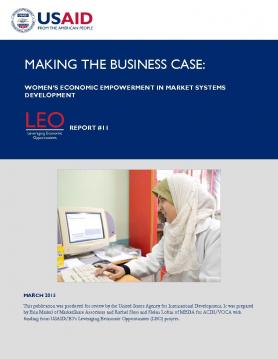You are here
Making the Business case: Women’s Economic Empowerment in Market Systems Development
Evidence shows that giving poor women the means to improve their incomes and the power to make decisions has a catalyzing impact within their households, their communities, and beyond. Moreover, there is growing recognition among global corporations that business practices that empower women are a sound investment.
Recognizing the untapped potential of women, the United Nations Entity for Gender Equality and the Empowerment of Women and the United Nations Global Compact has led dozens of new programs and initiatives, such as the Women’s Empowerment Principles (WEPs). With more than 850 CEOs signing a statement of support for the WEPs, pledging to advance equality between men and women by reforming their business practices.The USAID-funded Leveraging Economic Opportunities (LEO) activity seeks to build upon these efforts by demonstrating how business practices that are inclusive of women are good for business and social change.
This paper is based on extensive research and interviews and provides the rationale that market systems facilitation practitioners can use to engage private sector firms in efforts to empower women. From identifying partners to articulating the mutually beneficial value of women’s inclusion, the paper offers guidance and real-world examples to help companies empower women working at every level of the economy. It includes strategies to increase the bottom line for a wide spectrum of businesses, from multinational corporations to medium-sized firms and microenterprises in developing countries. To lay the groundwork for engaging prospective private sector partners, the paper addresses the (1) benefits of inclusive business for women’s empowerment, (2) deciding where to make the business case: targeting appropriate sector and business partners, (3) business case for including and empowering women, (4) key risks to the business case and (6)tactics for communicating the business case.
The audience for this paper is practitioners working in market systems facilitation programs that want to empower women through their activities.
Copyright © 2020 Grow Asia Terms of UsePrivacy PolicyContact Us

